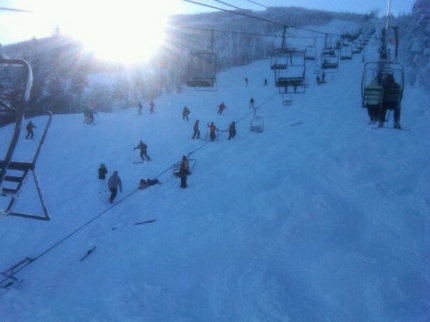Last week a chair lift at Sugarloaf Resort in Maine derailed injuring 8 people, none seriously. Nevertheless, the story was all over the news and internet.
But as I’ve argued before here, the degree of media coverage a given technology’s failure causes is inversely related to the chance of that failure’s occurrence.
So while it may seem counter-intuitive to believe, the fact that you actually saw a news report about a ski lift accident is evidence of the technology being really quite safe.
According to the National Ski Areas Association:
- there have been a total of 12 passenger fatalities involving ski lifts in the United States since 1973. This works out to 0.17 passenger fatalities per 100M passenger miles travelled.
- An additional 3 fatalities involved employees, trespassers and other incidents. If one were to include these 3 fatalities with the 12 described above, one arrives at a figure of 0.21 passenger fatalities per 100M passenger miles travelled.
- The last known gondola / aerial tram fatality occurred at Vail, Colorado in 1976; 4 passengers were killed.
- There hasn’t been a single reported lift-related passenger fatality at any ski area in the United States since 1993 and yet during the past 10 years an average of 40.6 people have died skiing/snowboarding each year.
Of course these numbers do not include non-ski lift area cable systems. But given the relative rarity of such systems in the United States, I think it reasonably fair to assume few if any additional fatalities. And while I could be wrong about this, I am unaware of any fatality in the recent history of aerial cable systems in urban areas of the United States. There have also been no fatalities associated with the Metrocable systems in Medellin and Caracas according to officials I interviewed last year.
Just to put things into perspective, the National Safety Council’s 2010 Injury Facts reports that in 2008:
- 39,000 Americans died in motor-vehicle accidents;
- 6,162 pedestrians were killed;
- 6,700 died from unintentional public falls;
- 3,800 died from unintentional public poisoning;
- 3,600 people drowned while swimming in public areas;
- 900 died while bicycle riding;
- 129 died from tornadoes;
- and 25 died from lightning.
That’s right, folks. You’ve got a better chance of dying in a tornado or lighting-related accident than you do riding in a gondola.
(I want to follow-up on this post with a comparison to other standard transit technologies. Data-gathering, however, is proving quite laborious. Stay tuned.)


3 Comments
Yes, it’s typical. I think people are getting used to car or train accidents. Somehow you do expect those things to happen. But for niche products, which are always a bit exotical by nature, the accidents are also exotical.
You might have seen car accidents, maybe witnessed one first hand, but you start to think for the first time what it would be like experiencing that kind. It’s spectacular. So far for people’s interest and interest of media – unless it will be common.. and boring.
I’m really looking forward to see you data posting. My guesses: separated forms of transportation will have the best results. Speed of transportation will be another big issue, also the direct location. But both last mentioned are secondary thoughts.
@ LX,
“I’m really looking forward to see you data posting.”
I think the post is more going to take the shape of how safety stats are gathered and reported, rather than what they actually are. You’ll be pretty shocked at the negligent way these things are reported in North America. I, for one, was pretty blown away from what I’ve found. Stay tuned. It’s an important post for me, but I don’t want to rush it so it may take a little longer than anticipated.